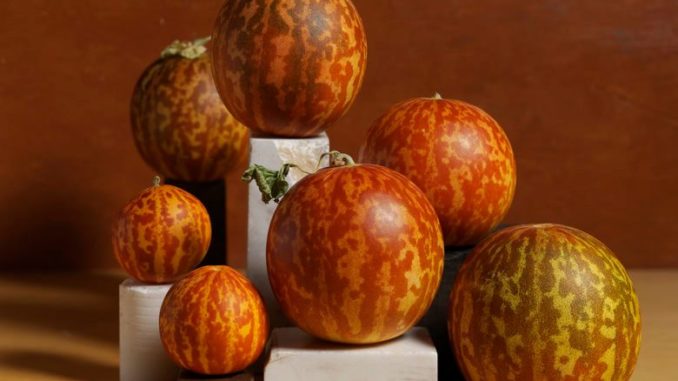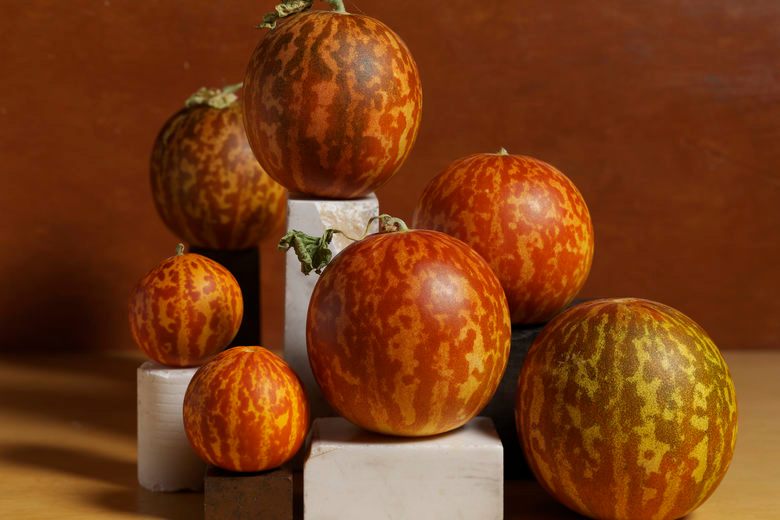
If you indulge a few hours of your time perusing “The Melon” — and I do mean indulge, since the author’s mouthwatering melon-eating accounts fill the pages of this book — your visits to the produce section of any grocery store or supermarket may never be the same again. Up until opening this volume, I had, at best, a distant relationship with melons, my interest confined to watermelon, muskmelon (the true name for what we call cantaloupe), and honeydew.
Having read this book, however, I have been sufficiently seduced to where I will never pass by a produce section again without noting the various melons on display. Moreover, I will make a point of taking home a melon I have never sampled each time I encounter one.
With all due respect, however, the taste of hybrid melons you encounter in the market is a far cry from the out-of-this-world sweetness of the heirloom varieties described by author Amy Goldman. “The seedless bowling balls that pass for watermelons and the less-than-honeyed honeydews in grocery stores across America don’t begin to describe the diversity of these crops,” Goldman sighs.
“The Melon” (City Point Press, 2019) may comfortably be labeled the last word on its subject. There are photos of 125 melon varieties, all of them taken by Victor Schrager during the 19 years that he collaborated with Goldman in creating this book. These artistic photos, I submit, are of a quality that would have made Caravaggio — whose still-life paintings from 400 years ago, that depicted melons with photographic exactitude — smile. Who knows? Melons just might turn out to be “the next big thing,” upon which we would all have prints of Schrager’s photos hanging in our living rooms.
“The Melon” is a book that serves many purposes: as a historical document, meticulously researched, on the origins and peregrinations of melon varieties that you never knew existed but will now be eager to try; as a compendium of recipes that include melon in salads, gazpacho, chicken dishes, desserts, and alcoholic beverages; as a practical guide to growing melons in your own backyard; as a resource of more than seventy suppliers of melon seeds, where the suppliers of seeds for nearly all of Goldman’s 125 melon varieties are listed so that you can send away for them now and have plenty of time to prepare your prospective melon patch for planting next year.
Before planting melons, your soil should drain well, but, if it does not “you can amend the soil in the fall by incorporating leaf mold and a generous helping of compost,” Goldman wrote, “or sowing a green manure or non-host (of pests or diseases) cover crop, such as winter rye, then tilling it in come spring.”
Our soil pH is usually on the alkaline side and since “the optimal pH range for growing melon and watermelon is 6.0 to 6.5,” you should be prepared to acidify your soil through incorporation of sulfur in the form of gypsum (just make sure you have a dust mask handy), a natural and inexpensive, if powdery, soil amendment that not only acidifies soil but improves drainage, too.
We live in an area of the United States that would appear to be more favorable for growing melons than any other. Melons are native to regions of Asia and Africa with a long, hot and dry growing season similar to Southern California’s. Some melon varieties can even be dry-farmed, meaning that their water needs are satisfied by winter rain alone. That is, given our average winter rainfall of 15 inches, if you were to plant seeds of most muskmelon and watermelon varieties in properly prepared and mulched soil in late March, you could harvest a crop in June or July without having had to water your plants even once. The difference between dry-farmed and irrigated melons, or any fruit for that matter, is that dry-farmed crops are sweeter, although their yield will be less, than irrigated ones. Dry farming of many crops, including melons, was commonplace in Southern California during the early decades of the last century.
Melon varieties are divided into just two species. The first is Cucumis melo, which includes muskmelons, honeydew, casaba, Crenshaw and a plethora of others, ranging from tennis ball-sized pocket melons with red skins and perfumed fragrances to thin, curvaceous snake melons that can reach six feet in length. The second species is Citrullus lanatus, the botanical moniker of watermelon and its related variations, including some with white or yellow flesh and others with golden skins.
If you want the seeds of the heirloom melons in your garden to bear the same quality fruit next year, plant one melon and one watermelon variety only, since these differing species cannot cross-pollinate. However, if you have neighbors up to half a mile away who are also growing melons, cross-pollination could occur.
Pollination of melons depends on intensive bee activity so if you can bring a beehive close to your melon patch – thevalleyhive.com can be of assistance — you should do so.
Make sure your melons get full sun and, to amplify ambient heat required for ripening, lay down black plastic mulch on your melon patch prior to planting.
Tip of the Week: The conundrum with melons, of course, is knowing when they are ripe and ready to eat. The advantage of growing your own is that each variety has its own harvesting protocol; some slip from the vine when they are ripe, others need to be slightly tugged, and still others severed from the vine with a pruning shears when they are ready.
According to Goldman, when shopping for melons in the market, “thumping and sniffing” are poor indicators of ripeness. With muskmelons, press the base of the fruit, opposite the stem end. “Immature melons do not yield to pressure,” she writes. “A melon is ready to pick or eat when the skin is fairly easy to depress.” However, “if your finger finds little resistance or elasticity or even breaks the skin, the fruit is kaput.” This test does not work on winter melons such as honeydews. Where watermelons are concerned, “the most reliable indicator of ripeness is a yellow rather than white ground spot on the underside,” but “if the darker green stripes contain too much yellow, the fruit is overripe.”





